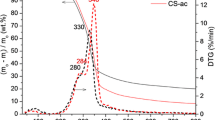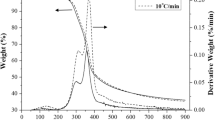Abstract
In this work, the torrefaction process of low-cost agricultural wastes (e.g., wheat straw and sunflower shells) was studied for manufacturing high-calorific materials for energy co-generation. The renewable bio-coal materials were manufactured using a continuous multiple-hearth torrefaction furnace (so-called CENTORRE by CMI group technology). The possibility of using this type of reactor allows a better control of the process and a better monitoring of the operating temperature. Two different conditions were evaluated under nitrogen atmosphere at an average flow rate of 100 kg h−1: (i) 250 °C; (ii) 280 °C. An increase on the torrefaction severities involves a greater loss of mass (at 250 °C: 23% w/w for wheat straw and 17% for sunflower shells; at 280 °C: 52% w/w for wheat straw and 56% w/w for sunflower shells). As expected, the carbon/oxygen ratio also increases as a consequence of the decomposition of the main polymeric chains (i.e., hemicellulose, cellulose, and lignin). The raw and torrefied biomasses have been characterized using SEM-EDX, TGA, and elemental analysis (C, H, N, S, O). The energy content increases with the temperature, the higher heating values were determined as 20.4 MJ kg−1 and 25.8 MJ kg−1 at 280 °C, for wheat straw and sunflower shells, respectively. Torrefaction enhances the valorization of low-cost wastes into solid fuels for local energy production.
Access this chapter
Tax calculation will be finalised at checkout
Purchases are for personal use only
Similar content being viewed by others
References
Rodriguez-Alonso, E., et al.: Study of solid chemical evolution in torrefaction of different biomasses through solid-state 13C cross-polarization/magic angle spinning NMR (nuclear magnetic resonance) and TGA (thermogravimetric analysis). Energy 97, 381–390 (2016)
Ladanai, S., and Vinterback, J.: Global potential of sustainable biomass for energy, report 013, Uppsala: Department of energy and Technology, Swedish University of Agricultural Sciences (2009).
Demey, et al.: Evaluation of torrefied poplar-biomass as a low-cost sorbent for lead and terbium removal from aqueous solutions and energy co-generation. Chem. Eng. J. 361, 839–852 (2019)
Chiou, et al.: Torrefaction of almond shells: effects of torrefaction conditions on properties of solid and condensate products. Ind. Crops Prod. 86, 40–48 (2016)
Lagergreen, S.: Zur theorie der sogenannten adsorption gelöster stoffe kungliga svenska vetenskapsakademiens. Handlingar 24(4), 1–39 (1898)
Van der Stelt, et al.: Biomass upgrading by torrefaction for the production of biofuels: A review. Biomass Bioenerg. 35(9), 3748–3762 (2011)
Sannigrahi, P., Ragauskas, A.J.: Poplar as a feedstock for biofuels: a review of compositional characteristics. Biofuel Bioprod. Bior. 4, 209–226 (2010)
Li, S., et al.: Torrefaction of corncob to produce charcoal under nitrogen and carbon dioxide atmospheres. Bioresour. Technol. 249, 348–353 (2018)
Acknowledgments
This work was supported by the European Union’s Horizon 2020 Research and Innovation Programme under grant agreement No 637020-MOBILE FLIP. The French agency for research (ANR) is acknowledged for partial funding of the GENEPI platform within the framework of the investments of future (Ref: ANR-11-EQPX-0019).
Author information
Authors and Affiliations
Corresponding author
Editor information
Editors and Affiliations
Rights and permissions
Copyright information
© 2021 The Editor(s) (if applicable) and The Author(s), under exclusive license to Springer Nature Switzerland AG
About this paper
Cite this paper
Demey, H. et al. (2021). Torrefaction of Wheat Straw and Sunflower Shells Biomasses as Low-Cost Materials for Energy Co-Generation. In: Ksibi, M., et al. Recent Advances in Environmental Science from the Euro-Mediterranean and Surrounding Regions (2nd Edition). EMCEI 2019. Environmental Science and Engineering(). Springer, Cham. https://doi.org/10.1007/978-3-030-51210-1_271
Download citation
DOI: https://doi.org/10.1007/978-3-030-51210-1_271
Published:
Publisher Name: Springer, Cham
Print ISBN: 978-3-030-51209-5
Online ISBN: 978-3-030-51210-1
eBook Packages: Earth and Environmental ScienceEarth and Environmental Science (R0)




